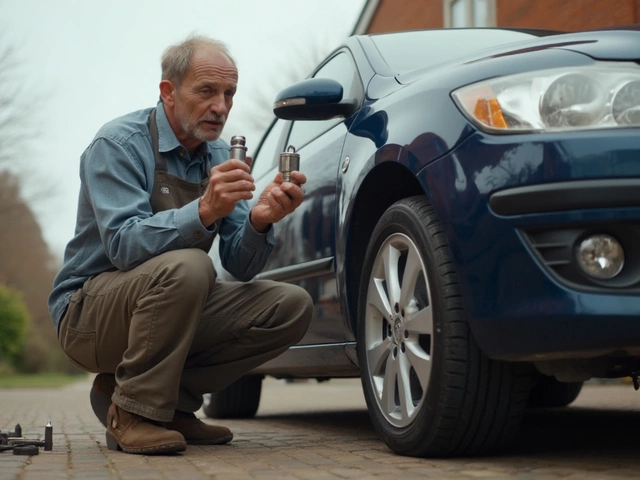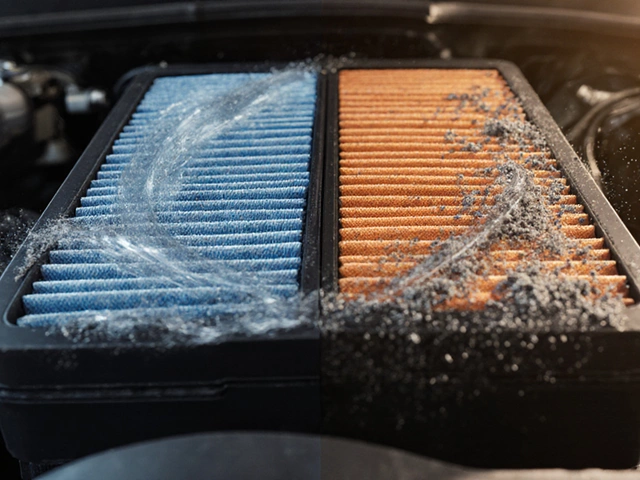Picture yourself tearing down the freeway, windows down, stereo up, and… your engine choking for breath. Sounds dramatic, but most drivers never think about what’s happening right under their hood. A clogged or restricted air filter can absolutely kill performance—and even regular filters can hold you back. That’s why it’s no surprise that a simple part swap has been hyped in car forums for years: ditching the factory air filter for a performance air filter. Some folks swear by the upgrade, while others are convinced it’s just clever marketing. So, what’s really going on here? And more importantly, is a performance air filter actually worth it for your car? Let's settle this.
How Do Normal Air Filters and Performance Air Filters Work?
Let's break down exactly what these filters do. Your car's air filter sits between the outside world and your engine. Its main job? Trap dust, pollen, bugs, tiny rocks—basically any junk that can damage your engine if it sneaks past. Most normal air filters (aka OEM or paper filters) use a pleated paper material packed inside a plastic frame. You’d think paper seems kind of basic and you’re not wrong. The pleats multiply the surface area so the filter can stop more debris, but they still get dirty after a while. That’s why every service schedule includes regular filter changes, usually every 12,000 to 15,000 miles, or even less if you drive on dirt roads.
Performance air filters, on the other hand, use higher-end materials and different construction. Instead of dense paper, you’re looking at cotton gauze, foam, or sometimes even synthetic mesh. The fibers are arranged to allow air to flow more easily while still catching nasties. Many have multiple layers with oil treatments to help grab fine particles. Brands like K&N, aFe, and a handful of others all basically play the same game: let your engine breathe more freely, in hopes of getting better power, response, or efficiency. These aren't just empty promises. When you install a performance air filter, you change how quickly and how much air can enter the combustion chamber, but we're getting ahead of ourselves.
Let’s look at a table for a quick comparison of the most common types you’ll find in the real world. This isn’t one of those sales charts—this is the kind of info you’d share with a buddy over beers in a garage:
| Feature | Normal Air Filter | Performance Air Filter |
|---|---|---|
| Typical Material | Pleated paper | Cotton gauze, foam, synthetic mesh |
| Expected Lifespan | 12,000–15,000 miles | Up to 50,000 miles, sometimes "lifetime" with cleaning |
| Maintenance | Replacement only | Clean and reuse |
| Airflow Restriction | Higher | Lower |
| Protection Level | High (for small particles) | Varies (can let in tiny fines if not oiled right) |
| Effect on Power | Neutral | Often 1–5hp gain |
| Cost | $10–$40 | $40–$120 |
So, a normal filter tells you exactly what you expect: it’s cheap, it’s simple, it does the job most of the time. Slap in a performance filter and you’ll spend more up front, but it might never need replacing, you could get a bit more punch, and you’ll cut down on garage waste too. But not everything that sounds cool in ads is actually a slam-dunk on the street—or the track. There are trade-offs you don’t hear about in all those “must-have” lists.

Performance Differences: Myths, Reality, and Day-to-Day Impact
There’s this urban legend that swapping your stock air filter unleashes your car’s “hidden horsepower.” Some videos hype up dyno results with those neon green or power-red filters, claiming it’s like giving your car a quick tune-up. Is that legit? Sort of… but with a reality check. Here’s what really happens when you install a performance filter:
- Stock engines: You might see a 1-5% bump in horsepower. If your car’s making 200hp, it could mean 2–10hp more—not exactly race-winning, but it is something, especially if you drive a turbo or supercharged engine that breathes lots of air.
- Throttle response: This is where a lot of drivers notice a change. Acceleration feels a touch snappier off the line, especially in hot weather or when your stock filter was already getting dirty. Better airflow can help your car jump faster from a stop.
- Fuel economy: This one’s tricky. Yes, in theory, less restriction means the engine doesn’t work as hard pulling in air, but gains are usually too small to measure in day-to-day driving. Maybe half a mile per gallon, if that. If you drive like a madman, expect zero improvement—or even worse mileage, because you’ll enjoy that little bit of extra power more often.
- Engine sound: Believe it or not, a freer-flowing filter can make your engine sound more throaty. You might hear more induction noise, especially if you use a cone- or pod-style filter that replaces the whole airbox.
Here’s the catch: the benefits drop off fast if the rest of your intake system is restrictive. If your airbox, intake plumbing, or MAF sensor are tiny or plastic, a fancy filter won’t perform magic. Also, look at what car you drive. On a regular Corolla, don’t expect a transformation. On a turbo’d hatch or a V8 with a ram-air scoop, you might get a little more go. Performance filters shine brightest in cars that already crave more air—like high-revvers, force-inducted engines, or cars you’ve already tuned with other mods (headers, exhaust, ECU remap).
This brings up another juicy point: the myth of “too much air.” People sometimes argue that a performance filter lets in more dirt, or that your engine won’t benefit unless you change the whole intake system. There’s some truth buried there. High-flow filters can let in more fine dust—especially if you’re careless and don’t oil it right after cleaning. That risk matters if you live where the air is full of pollen and grit (hello, Arizona and Texas), or if you drive on construction sites or farm roads. Most of the time, though, this isn’t a dealbreaker. Cotton gauze and foam types catch most stuff, and if you’re on a paved road, you’re not exposing your engine to a sandstorm daily.
Now, about cleaning and re-oiling. This is something the sales reps often gloss over. Unlike regular paper filters, most performance units need maintenance every 20,000 to 50,000 miles. Cleaning isn’t hard—just soap, water, dry, and then re-oil (if your filter type needs it). But if you forget or mess up, airflow decreases, or your engine eats some fine dust. So, there’s no such thing as “maintenance-free” here, even if you never have to throw one away. Owners love that these filters pay for themselves after 2–3 cleaning cycles instead of buying fresh ones all the time.
Here’s a tip: If you want real gains, pair up a performance filter with a cold air intake and a tune. Otherwise, expect modest improvements that probably won’t surprise anyone but might save you some cash down the road. And by the way, on some newer cars, replacing the stock filter with a performance model can trip a check-engine light if the MAF starts reading differently. That’s rare but happens—so keep your old filter just in case.

When to Choose Each: Tips for Daily Drivers, Enthusiasts, and DIYers
If you’re thinking, “Okay, so is a performance air filter actually worth it for my car?”—well, it depends a lot on your driving and your expectations.
- If you just putter around town, driving a couple of miles in regular traffic, a normal air filter is cheap, works reliably, and is easily changed with every service. You’ll never notice minor horsepower or noise changes.
- If you’re an enthusiast who likes to squeeze every ounce of power or wants the engine bay to look cooler (yes, there’s something satisfying about a bright red or blue filter), then a performance air filter is fun to try. Especially if you combine it with bigger mods down the road.
- Breathe dusty air on the regular? You might still want to stick to paper or factory foam filters. It’s not glamorous, but protection always beats cool factor if longevity is your goal. Ask rally drivers—they use super-dense paper or foam for a reason.
- If you hate wasting stuff, the reusable angle is attractive. You clean, you re-oil, you skip a landfill trip. Just don’t forget to service it, or you could do more harm than good.
Another angle: warranty issues. Most aftermarket air filters won’t void your car warranty by law in North America, but if your dealer sees weird stuff in the intake or a MAF sensor covered in oil, expect a little debate. That’s why it pays to research your car’s specifics. Check out trusted forums or club Facebook pages—see what people with your exact model have experienced.
There’s also the cost side. A standard paper filter costs about $10–$40. Performance models jump to $40–$120. But if you own your car for years, clean your filter religiously, and like changing things up yourself, you’ll break even after three or four service intervals.
Some quick advice for those who want to swap or upgrade:
- Follow the cleaning instructions to the letter—don’t use random detergents or skip the oil if it’s required. Skimping here can ruin your engine.
- If your car has a mass airflow (MAF) sensor, clean it after swapping filters. Oil from reusable filters can sometimes cause gunk buildup or sensor errors.
- Avoid generic or “super-cheap” performance filters from mystery brands. They’re often little more than a colored mesh and a fancy box. Go with a trusted brand with real test data.
- Watch for fitment. Some performance models need the lid of your airbox trimmed or the box itself swapped. That can be a pain if you want to put the stock part back for inspections or emissions tests.
- If you drive somewhere with strict emissions checks, check your local laws. Some cold air or open filters aren’t road-legal everywhere.
So, is the hype real? Kind of. On a high-strung engine, a performance air filter brings out that last bit of hidden energy. On a daily driver, improvements are mild—but you’ll still get longer service intervals and a more eco-friendly setup if you maintain it right. Either way, you’ll know your engine's breathing easier, and maybe, just maybe, you’ll tap into that little bit of mechanical joy every time you put your foot down.




